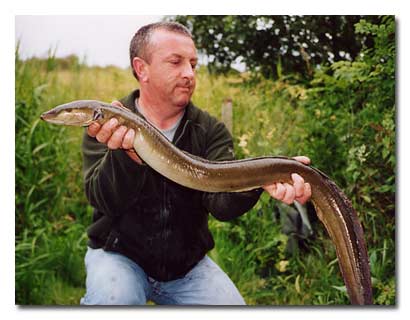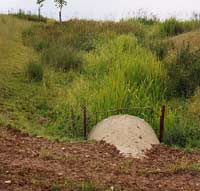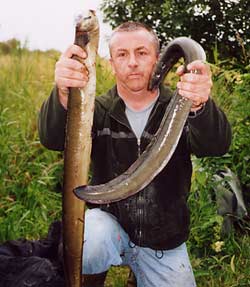| From a young age the eel has been a bit of a passion with me, with many of our family holidays being spent near rivers ‘accidentally’ arranged by Dad! Dad had been a youngster during the war years and along with many of his generation had developed a taste for the fruits of the river. A freshly caught eel was much prized to fry up with the holiday breakfasts of bacon and eggs and the taste stayed with him. To me as a youngster it was the source of much pride to be the hunter and provider for the breakfast table when on holiday, and besides there was the chance of an extra rasher of bacon for me!
in those days I learnt a great deal about the eel and spent many years catching them from rivers of all descriptions. I wouldn’t take them for the pot nowadays, not because I think it wrong to take the occasional one but more because of if what I read about the chemical levels in them is true then they shouldn’t be eaten anyway, but I have no objection to anyone taking a couple from a prolific water. John Sidley, the king of eelers As I grew into my teens I was still relying on rivers for my eel fishing but I began to take an interest in tales of monsters from stillwaters. By the mid-70’s I had joined the ranks of the many midland eel anglers of the time. The weeklies of the day carried stories of the likes of Merv Wilkinson and Phil Smith catching some huge eels from a ‘Wolverhampton’ reservoir and of course probably the most well known eeler of all time, the late John Sidley, who was very active on Earlswood lakes (very different waters then!). John was out on his own as an eel angler. I have never met anyone as fired up as him for a species, his enthusiasm never waned and he would be out in all weathers. I remember one year fishing the final weekend of the season on the Severn at Tewksbury weir for pike, john was there too and the following weekend he insisted I went eeling with him! And I have no doubt if he were still with us he would still be eel angling today. Midland’s angling is poorer for his passing; he was the sort of character that angling is lacking today. A textbook big eel water
It was a textbook big eel water: medium sized (25-plus acres) gravel pit situated in a river valley. It had ditches and drainage channels linking it to the river. It had an abundance of life within it, insect life, snails, loads of spawning fish, small fish, the lot! And more importantly, no one was fishing it for eels, in fact only about four of us were fishing it; perfect credentials and potential for a big eel. When I think of years gone by where I have wasted time fishing waters that have already been creamed it makes me cringe. Nothing, but nothing, will guarantee blanks more than an eel water that has been ‘hit’ already. Eel fishing is not as hard as some would have you believe – the secret is to be first on the water and keep stum! They will disappear if subjected to pressure. Having said that there are plenty of ‘old’ eel waters that are ripe for a rematch once time has passed. Why eels disappear
Any new ideas about eel baits? An area of angling that has seen some monumental changes is bait. Has the modern bait scene anything to offer the eel angler? In my opinion not a lot. Sure, boilies and pastes will catch the odd eel, I’ve caught them accidentally on loads of different things. Meat, bread, boilies, maggots (biggish ones too, not bootlaces) and couple this with what I know others have caught them on then they certainly seem to have very varied tastes. Truth is though that they are scavenging predators and that is why they have been caught on such a variety of baits, but in my opinion natural baits will always outfish ‘specials’. Friends who have spent more time than me experimenting back this up and most of them are happy to stick with lobworms and freshwater deadbaits nowadays. I want them fresh too!
To sum up with baits then I would be happy with lobworms, freshwater deadbaits and deadbait sections, but I am willing to experiment more with maggots and always use maggots as an attractor anyway, usually flavoured with Multimino. Well, what self respecting snig could resist extracts of fresh liver, fresh spleen, and gastric mucosa? Think like an eel! Someone once wrote that to catch a fish you have to think like a fish. I think that is sound advice and I think the eel for all its mystique in other ways is one of the easiest to think like and locate. That’s not to say that a chuck anywhere will locate them! Eels love marginal rushes especially, so at spawning time and if your water has them and you frequently disturb small fish when walking by them then you could have found a real hotspot. Those small fish are sheltering in the rushes from predators, come the night and the biggest eels in the lake will move in on them. They are ruthless hunters in these situations and a punctured deadbait or head section fished close in against the rushes is guaranteed to attract the attentions of an eel at some time. Try to put yourself in the mind of an eel in its search for food and think about the opportunities your water offers for them to scavenge or hunt: weedbeds and rushes at spawning time, the same places later on too when they offer some cover to fry anywhere the eel can capitalise on food supplies. I wouldn’t fancy being a small roach hiding in the rushes with a few big eels on the prowl. Talk about no hiding place!
No need for special gear There is no need for any special gear for eeling. Anyone with a decent couple of carp rods and the associated gear can soon kit themselves up for an eel session. I tend to fish fairly heavy for them, simply because I can’t see any reason not to and I always think that if that huge beast comes along at least my gear is up to it! My recommendations would be 21/2 to 3lb test rod, 12-15lb line and a hooklink that is up to the job – mono isn’t! This year for my hooklinks I have used the heavy braids that cat anglers use and found it great stuff, no bite-offs and no sign of damage with eels to 5lb-plus of the toothy variety. (Eels in some waters grow considerably larger teeth than others. The theory is that the toothy variety are accustomed to feeding on fish whereas the eels with small teeth are more used to feeding on bloodworm and other crustaceans). If pike are present you will have to decide what to do, though I have had a couple on the braid and again it was fine. Personally I am prepared to stick with it, even if a pike bites me off. It will, in my opinion, have no problems with a single hook – it’s not going to sew them up like a set of trebles. My favoured bite indication method Decent indication of an interested eel is an important requirement. I personally favour front mounted alarms coupled with butt indicators. Okay, there will be many ‘false bites’ as smaller eels hit ‘n spin into your bait, but clipped-up drop-off alarms WILL exaggerate deep hooking. I have hooked many twitchers when eeling and I’m convinced at least some of them would not have pulled line from the drop-off clip until the eel was deep hooked. Drop-off type alarms also make it to easy to fall into a deep sleep if you are that way inclined! My biggest eel this year came because I picked up the rod to check what I thought were bootlaces hitting the deadbait and just moving the butt indicator a little. You can sometimes tell this by holding the mainline tight to the bait. You can actually feel them spinning chunks off the bait, but this time it didn’t feel like bootlaces so I hit it. Result, one lip-hooked 5lb eel. Front mounted alarms like Delkims coupled with butt indicators tell a far better story than drop-off types, at least for eel fishing.
I suppose the part that puts a lot of anglers off eel fishing is the dealing with it after landing it. Friends of mine who are good anglers make no secret of the fact that they don’t fancy handling big snigs. But the fact is that a big eel is easier to handle than bootlaces. Years ago eelers actually used to cut a cross in the ground and lay the eel upside down in the groove to get rid of the devil in the fish! Of course there’s no need to cut a cross but holding the eel upside down for a while certainly calms it down a little. Apparently though, holding them this way for too long can damage them and cause death. I’ve never had it happen but just in case I only do it for the minimum time needed to unhook and/or photograph them. As I said earlier, only try to remove the hook if it is easy to do so, use as small a hook as you can get away with. The eel has, in my opinion, more chance of survival if the hook is left alone if deep hooked. If you want to keep the eels you catch at night until daylight then they are happy enough in a decent keepnet. Give it a go – catch the fish of mystery! So if you fancy a change and you feel a water you fish has eel potential why not give the most mysterious fish in our waters a try? You never know, you may enjoy it. I know I do! No known fish, no named fish, more travelled than hump-back, garlic breathed carp, and probably uncaught before. And the bit that always excites me when I get a take – no idea how big the next one could be! Feel free to ask for advice on the FM forum. |
Welcome!Log into your account
















